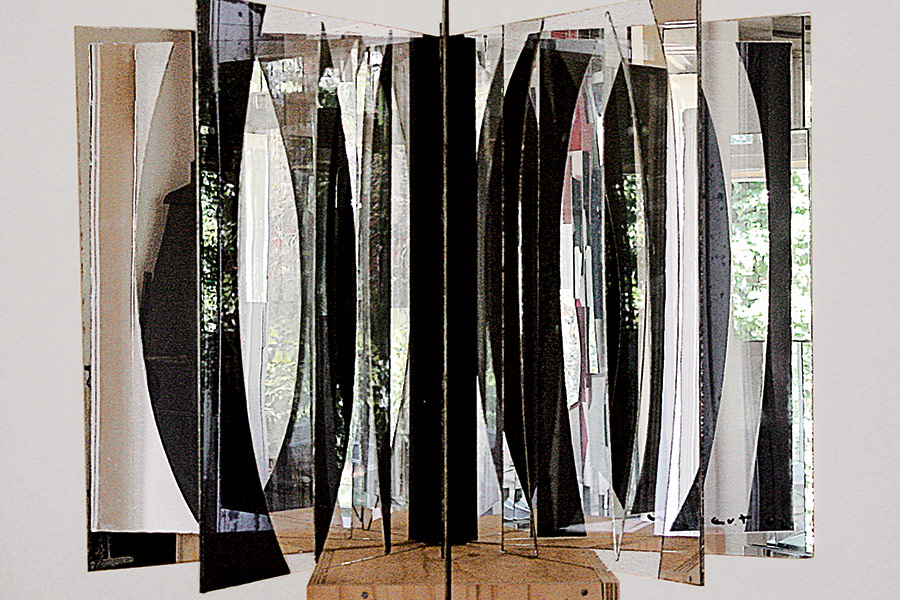
Countdown to Tomorrow, 1950s–60s
Guggenheim New York
1071 5th Avenue, New York, NY
Through January 7, 2015
Visiting the Guggenheim’s rich and exhaustive exhibition ZERO: Countdown to Tomorrow, 1950s–60s, one is struck by the dramatic difference between that moment and our current cultural climate. While in nearly every decade “collaborative art” becomes a fashionable approach to art making, the notion behind this joint effort was not a marketing concoction or mere stylistic designation. On the contrary, what united the three young German artists in the group known as Zero (Otto Piene, Heinz Mack, and Günther Uecker) was an ideological position that involved profound experimentation and the desire to sweep the slate clean in a way that resembled the utopian visions of the early 20th century.
One can detect diverse threads connecting Zero to those revolutionary isms that were striving to break the rules governing conventional painting and sculpture. By questioning the very nature of the art object—traditionally remote and inviolable—the early modernists intended to redefine art making at its most basic level. They achieved their goal in various ways—sometimes by merely fracturing the contour of forms to suggest movement, as in Futurist work, or by suspending the sculpture so that the base became a mere vestigial indication of its own irrelevance. Critic and art historian Jack Burnham traces this development in his seminal work on 20th century sculpture, Beyond Modern Sculpture. Writing in 1968, he described the way the artists hoped to extend the nature of sculpture beyond carving, casting, and constructing, and enumerated the ways experimental artists strove to animate an essentially static mode. Included among those he cited as transformative are the Zero artists, who intended to refine and expand our perceptual capacities by employing both real and virtual movement. They generated work that commands close attention and careful watching in order to catch the subtle shifts that occur, or seem to occur. Sculpture, once fixed, became experiential.
It is important to note that while clearly connecting to previous experimental work, the explorations of the German group significantly affected the next several generations of artists. The expanded field that we see in Uecker’s New York Dancer I (1965) and in Piene’s mechanized Light Ballet (1969) paved the way for many strains of kinetic art, certain kinds of minimal sculpture, land art, performance work, and especially the endless proliferation of installations. In many ways this show hopes to correct the oblivion into which most historical movements have fallen, as younger artists seem little concerned with their own sources and precedents. This exhibition, whether one finds the work aesthetically pleasing or not, does provide essential clues for understanding the buzz suffocating much of contemporaryart, which relies on an avant-garde cache for its success.
Impelled by a positive energy during the post-war recovery period, the artists of Zero were reacting against the hyper-personal sensibility seen in the European Art Informel and Tachism, as well as American Abstract Expressionist notions. The exhibition reveals how their initial efforts expanded to include artists from around the world—extending the original concepts, offering variations, including local forms, generating cross influences, and, in the process, making it a difficult movement to pin down. The curators convey the complexity of the movement by situating the individual art works in historical context, and by citing specific exhibitions, live events, and publications. For these artists wrote and spoke about their work in grand utopian terms. In particular, the films documenting the spectacles provide a sense of the magnetism of the principle figures, who were not content to retreat into their private studios but required a live and responsive—or even participatory—audience. The marvelous clips provide a real sense of the theatrical or spectacular aspects of the works. Watching as Lucio Fontana plunges his knife into the surface of the canvas, one senses the powerful and pervasive macho element (the show includes only 3 women) and how the wide-ranging works in the show oddly manage to coexist and complement each other—from the quirky burned canvases to the cool, slick, corporate sensibility of many of the sculptures. The shining, anonymous metallic sculptures, the necessary decoration for modernist buildings from the 1950s and 60s, are all too familiar today.
This exhibition, beautifully organized by Valerie Hillings, establishes certain common themes: kinetics, explorations in materials and visual effects, technological experimentation, and in the case of the late, charismatic Otto Piene, an investigation into the potential for art experiences derived from the power of elements like air, fire, and earth. In many ways, the exhibition is a poignant memorial to an indefatigable force and the spirit of risk and invention.